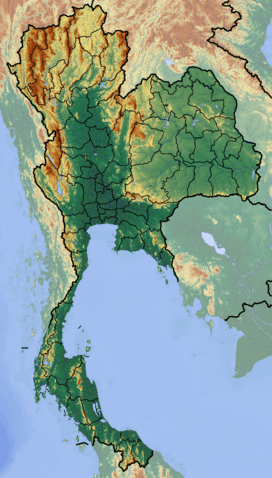Thap Lan National Park
| Thap Lan National Park | |
|---|---|
|
IUCN category II (national park) | |
 | |
 Location in Thailand | |
| Location | Prachinburi, Nakhon Ratchasima and Buri Ram provinces, Thailand |
| Nearest city | Kabin Buri |
| Coordinates | 14°12′N 101°55′E / 14.200°N 101.917°ECoordinates: 14°12′N 101°55′E / 14.200°N 101.917°E |
| Area | 2235 km² |
| Established | 1981 |
Thap Lan National Park (อุทยานแห่งชาติทับลาน) is located in the Sankamphaeng Range, Prachinburi, Nakhon Ratchasima and Buri Ram Province, Thailand.[1] Established as a national park on December 23, 1981, it was the country's 40th. Its attractions include: Lan Forest and Recreational Garden (ป่าลานและสวนพักผ่อนหย่อนใจ), Namtok Thap Lan (or Namtok Heo Nok Kok) (น้ำตกทับลานหรือน้ำตกเหวนกกก), Thap Lan Reservoir (อ่างเก็บน้ำทับลาน), Namtok Huai Yai (น้ำตกห้วยใหญ่), Lam Mun Bon Dam (เขื่อนลำมูลบน), Hat Chom Tawan (หาดชมตะวัน). The superintendent is Taywin Meesap.
Geography
With an area of 2,236 square kilometres (863 sq mi), it is Thailand's second largest national park.[2] Thap Lan's headquarters are in Bu Phram, Na Di, Prachinburi Province. The park is situated within multiple provinces. Its areas include Tambon Bu Phram, Amphoe Na Di, Prachin Buri; Amphoe Pak Thong Chai, Wang Nam Khiao, Khon Buri, and Soeng Sang of Nakhon Ratchasima Province; and Amphoe Pakham of Buri Ram Province. The highest peak is 992 metres (3,255 ft) high Khao Lamang.[2] Terrain includes mountain ranges, valleys, chasms and waterfalls.
Flora and fauna
Flora includes palm forests. Mammals that thrive within the park are boar, clouded leopards, deer, elephants, and spotted linsang. Avifauna include lapwings, laughing thrushes, and myna. According to researchers, the park may have more tigers than China.[3]
Conservation
Queen Sirikit's Dong Phayayen-Khao Yai Forest Complex includes Thap Lan and five other related areas, Khao Yai National Park, Pang Sida National Park, Ta Phraya National Park, Phraphutthachai National Park, and Dongyai Wildlife Sanctuary.[4] While elephant hunting is common in the Dangrek Range, they are better protected within Thap Lan.[5]
References
- ↑ Spooner, Andrew; Borrowman, Hana; Baldwin, William (February 1, 2007). Footprint Thailand. Footprint Travel Guides. pp. 704–. ISBN 978-1-904777-94-6. Retrieved October 1, 2011.
- ↑ 2.0 2.1 "Thap Lan National Park". Bangkok Post. Retrieved 1 October 2011.
- ↑ Watts, Jonathan (16 May 2011). "Thailand jungles mask surprise rise in tiger numbers". The Guardian. Retrieved 1 October 2011.
- ↑ "Thap Lan National Park". dnp.go.th. Retrieved 1 October 2011.
- ↑ Sukumar, R. (April 30, 1993). The Asian Elephant: Ecology and Management. Cambridge University Press. pp. 21–. ISBN 978-0-521-43758-5. Retrieved October 1, 2011.
External links
| Wikimedia Commons has media related to Thap Lan National Park. |
| ||||||||||||||||||